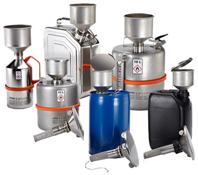x
I
n
k
a
r
p
Funnel

Funnel
- Safety funnels allow safe and comfortable filling of plastic canisters, combi-barrels and 2"-barrels
- Safety funnels neeed to be screwed on container, have a flame trap, an overfill protection as well as a closure head to reduce vapors
- Grouding through direct contact in case of conductive containers - for all others there is an extra grounding connection
- Flame traps of safety funnels can be unscrewed and removed, e.g. for easy cleaning or exchange
- Plug-in funnel for easy and safe filling of safety cans, -canisters and -barrels

